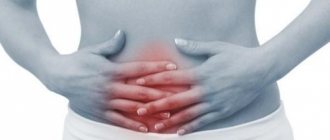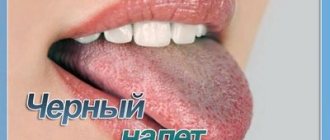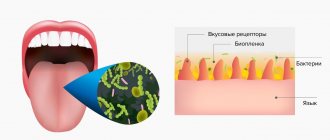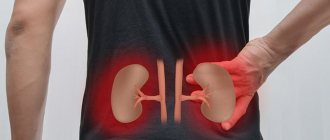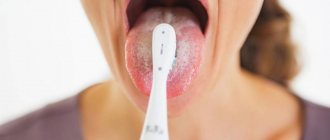The appearance of an unpleasant odor from the mouth, medically called “halitosis,” is a signal of trouble in the growing organism. Kaliningrad residents can notice this symptom when communicating with a child, laughing or kissing.
In most cases, odor occurs due to poor hygiene, which disrupts the balance of microflora in the mouth and increases the number of pathogenic microorganisms. During the decomposition of bacteria, compounds of hydrogen sulfide and nitrogen are formed, which are exhaled along with the air.
In this situation, the problem can be solved with the help of hygiene and does not pose any danger to the child’s health. However, there may be other reasons for the appearance of a specific odor from the mouth. In what cases should parents be wary - we will find out further...
Risk factors affecting fresh breath
Let's start by identifying the reasons that negatively affect healthy breathing. At the same time, we note that microflora imbalance can occur even in healthy children. This happens for a number of reasons:
- failure to comply with hygiene rules, as we have already outlined;
- dry mouth due to insufficient saliva;
- insufficient water and fluid intake;
- breathing through the mouth, out of habit or due to nasal congestion;
- oral infections (untreated caries, gum disease, etc.);
- consumption of foods with a pungent odor (garlic, onions) or those that provoke fermentation (legumes, grapes);
- taking medications;
- hormonal imbalance;
- smoking (relevant for teenagers).
Thus, in most cases, the cause of bad breath is problems in the oral cavity, infections and poor diet.
Psycho-emotional state disorder
Sometimes halitosis can occur in children after severe excitement.
In some cases, the cause of halitosis may be hidden in the environment that surrounds the child. The fragile psyche reacts too painfully and sensitively to stressful situations, which can be almost invisible to adults, but for a child they are a serious test.
When the nervous system is overexcited, dry mouth, acetonemic crises with all their consequences mentioned above, and digestive disorders are possible.
You need to talk to your child to try to find out the root cause of worries and fears. Maybe he has problems in the children's team (conflicts in the yard, at school or kindergarten). Older children also have more serious problems. Sometimes this syndrome can occur due to failures in studies or during exams.
Children often have problems with their home environment - they experience constant fear of possible punishment for various little things - unassembled toys, something dropped on the floor, etc. He may be afraid to once again disturb adults with a question that worries him, as he may receive an irritated answer.
Such a nervous state often results in various disturbances in the functioning of the child’s body, which can result in bad breath.
If your baby is very worried, give him a slightly acidified drink and calm him down by any available means. Once the environment is normalized and stress is relieved, halitosis should disappear.
How to distinguish a normal smell from a problematic one?
If an unpleasant symptom occurs exclusively in the morning and goes away after brushing your teeth, then we are talking about a physiological norm. If bad breath is observed after hygiene procedures and becomes protracted, then this deviation requires the closest attention from parents.
In addition, it is worth noting that the above risk factors can be eliminated. However, if hygiene is maintained, respiratory infections and specific foods are excluded, and the unpleasant symptom persists for a long time, this is a good reason to consult a doctor.
In this case, altered breathing can signal very specific diseases. Let's look at which ones further...
Feces and its features in children of the first month of life
A newborn with diarrhea can be calm
What constitutes the basis of a newborn baby's diet? This is breast milk or adapted formula. These foods are liquid and therefore the stool contains more water than the feces of an adult.
The nature of feces in a baby of the first year of life:
- The first and second days after birth, the stool is black, viscous and sticky. Defecation several times a day. This is meconium and such bowel movements are normal.
- The third day and before the introduction of complementary foods - the feces are yellow and soft, watery. Sometimes you come across curdled pieces in small quantities. Bowel movements occur several times a day.
If the baby uses an adapted formula, the color of the stool may have a greenish or black tint. Typically, formulas are fortified with iron to prevent anemia. This is what gives stool such an unpleasant tint. After the introduction of complementary foods and with the expansion of the diet, the color of feces gradually becomes similar to the feces of an adult. Bowel movements occur 1–2 times a day.
If your baby passes liquid stool, but is not worried, eats well, gains weight, actively plays and develops according to age standards, then there is nothing to worry about. After switching to a more adult diet, the feces will become denser and will delight the parents.
List of diseases that can be detected
Despite the fact that halitosis is not a disease, it is an important diagnostic symptom by which a specialist can assume the presence of a certain disease in the body. Suspected health problems may include:
- diseases of the nose and nasopharynx: sinusitis, pharyngitis, tonsillitis, adenoiditis;
- food allergies or respiratory rhinitis causing nasal congestion;
- dental diseases of teeth and gums;
- Gastrointestinal diseases: gastritis, increased stomach acidity, intestinal dysbiosis, etc.;
- endocrine disorders: diabetes, thyrotoxicosis, etc.
As can be seen from this impressive list of diseases, solving breathing problems can fall within the competence of a variety of highly specialized specialists: otolaryngologist, dentist, gastroenterologist, endocrinologist.
What to do if a small child has terrible breath during an acute respiratory viral infection
When seasonal viral diseases (including sore throat) occur, severe inflammation occurs in the baby’s nasopharynx. It can appear on the tonsils, throat, nose (with sinusitis), lungs, depending on the specific disease. As a result, the inflamed areas become covered with plaque and pus, which creates stale, unpleasant breath. But don’t worry, halitosis goes away as soon as the children recover. Doctors always prescribe regular rinsing with antiseptic solutions (furacilin, rotokan and others), they quickly get rid of stench.
What can a smell “tell”?
As we mentioned earlier, unhealthy breath can quite eloquently indicate a certain nature of the disease. For example:
- a sour smell indicates problems with the stomach: high acidity, reflux or dysbacteriosis;
- the smell of a rotten egg - about a stomach ulcer or a violation of bile outflow;
- putrefactive – about diseases of the esophagus and low acidity of the stomach;
- acetone – about problems with blood sugar levels (diabetes) or dehydration;
- ammonia - about kidney disease, liver dysfunction and diffuse toxic goiter;
- boiled cabbage - problems with metabolism, liver and kidney diseases.
As a rule, already at the stage of collecting anamnesis and during the clinical examination, the doctor can make an assumption about the true causes of the problem.
What measures to take
Bad breath in children should not be ignored. Diseases inside the tissues of the oral cavity and internal organs can occur without significant symptoms, and such a seemingly insignificant symptom allows you to consult a doctor in a timely manner and begin the necessary treatment.
If you experience bad breath, it is recommended to contact a pediatric dental clinic. The specialist will examine the oral cavity, prescribe a diagnosis and, if the development of oral diseases is confirmed, carry out treatment. Often, to combat bad breath from a child, it is enough to start brushing your teeth properly and change your diet.
If, based on the diagnostic results, the specialist suspects the development of pathologies of internal organs or the respiratory system, the doctor will give the necessary recommendations and refer the patient to a more specialized specialist.
Diagnosis and treatment
To diagnose ENT diseases, an otolaryngologist uses hardware and laboratory tests. These include:
- rhinoscopy – to examine the nasal cavity;
- radiography and computed tomography - to assess the condition of the sinuses;
- examination of nasal secretions to determine the causative agent of inflammation;
- Blood and urine tests will complement the clinical picture.
In the process of collecting anamnesis, the doctor is interested in the following questions:
- How long has the child been complaining of discomfort?
- What time of day does the smell appear and how long does it last?
- What foods did the child eat?
- how much water does he drink?
- Does the smell go away after brushing your teeth?
- What chronic diseases does he have?
- what medications does he take?
Treatment does not imply the elimination of the symptom itself, as such, but the therapy of the specific disease that provoked its appearance. If, as a result of examination and diagnostic measures, pathologies of the nose or nasopharynx were identified, the doctor will prescribe adequate drug treatment, which may include:
- antibacterial therapy (taking antibiotics);
- vasoconstrictors and antihistamines;
- special medical procedures;
- physiotherapy: inhalations, UV and UHF therapy;
If necessary, the otolaryngologist can refer a small patient to specialized specialists if the solution to this problem falls within their competence (dentist, gastroenterologist, etc.).
Bad breath can cause respiratory diseases
If there is no visible pathology in the oral cavity, visiting a pediatric dentist can also add clarity to the fact that the cause of the unpleasant odor may be respiratory diseases. And if there are no other symptoms, you should definitely go to the pediatrician.
Tonsillitis
Acute or chronic forms of tonsillitis (inflammation of the tonsils) contribute to the accumulation of pathogenic microorganisms and their reproduction, the formation of mucus and suppuration. Very often this condition is accompanied by bad breath.
The structure of the tonsils themselves is cavernous; small decomposing particles of food sometimes accumulate in their cavities.
Regular gargling should be included in the list of mandatory hygiene procedures.
Bronchitis
With bronchitis (inflammation of the respiratory tract) of various etiologies or pneumonia, often bad breath can be one of the manifestations of these diseases.
A lot of sputum accumulates in the bronchioles and bronchi, which comes out when coughing, and it is accompanied by an unpleasant odor.
Adenoids and rhinitis
One of the causes of bad breath is accumulated phlegm.
With rhinitis (runny nose) of an allergic or infectious nature, purulent masses always form abundantly, and discharge flows down the back wall of the nasopharynx. This mucus decomposes under the influence of bacteria, resulting in the release of volatile sulfur compounds with a very unpleasant odor.
When the adenoids are inflamed or overgrown, when they block the posterior nasal passages (most of their lumen), as well as a runny nose, the baby breathes through the mouth, which causes the oral cavity to dry out. This contributes to the massive proliferation of colonies of microorganisms and various unpleasant symptoms.
Why do adenoids enlarge in a child?
For small children, be sure to make sure that he does not put anything in his nostril. The baby could even forget about it and the foreign body does not bother him in any way, but this will result in irritation of the mucous membrane, secretion of mucus with an unpleasant odor and difficulty in nasal breathing.
Preventive recommendations
In conclusion of our review, I would like to draw the attention of parents to adjusting their children's diet. Our nutritional recommendations are as follows:
- Let us remember that “bad” bacteria love a sweet environment, so it makes sense to limit the consumption of industrially produced sweets and sugar.
- As a dessert, you can offer your child natural sweets made from dried fruits and nuts, as well as fresh fruit.
- Replace carbonated drinks with pure water or herbal tea made from chamomile and mint.
- To create beneficial microflora in the intestines, a child should consume more “live” fermented milk products: cottage cheese, kefir, yoghurts.
Parents need to understand that this delicate problem requires a qualified approach, since over time it can lead not only to problems at the physiological level, but also cause social isolation of the child.
Kaliningrad residents can make an appointment with a pediatric otolaryngologist by filling out an online form on our website or by calling: +7 (4012) 357-773 or +7 (4012) 973-100.
Causes and mechanism of regurgitation
The following reasons are identified:
- Filling the stomach with air, which the child can swallow while eating. This is the most common reason, which requires practically no special correction.
- Muscular weakness of the valve between the esophagus and stomach. It develops as the child grows and begins to function normally by the first year of life. Therefore, food can pass from the stomach into the esophagus without hindrance, which is what happens during regurgitation.
- Food allergies (or food intolerances). Most often it manifests itself as skin reactions, but in rare cases, regurgitation may be a symptom.
- Congenital defects of the gastrointestinal tract. The digestive system is quite complex; some disturbances in its structure can lead to digestive problems that begin to appear immediately after birth. Thus, narrowing in the area of the gastrointestinal junction can lead to frequent atypical regurgitation.
Next, we will provide recommendations on how to distinguish pathology from the norm, and when you need to see a doctor. If regurgitation is caused by a disease, then it is reasonable to begin treatment as soon as possible.
Preventive measures
To promptly prevent the appearance of halitosis in your baby, you must follow a few simple rules:
- Brush your baby's teeth thoroughly twice a day, starting when the first tooth emerges. It is necessary to teach your child how to use a brush and toothpaste correctly to remove plaque from the surface of the teeth.
- Adhere to the age-specific nutrition system, introduce vegetables, fruits, and foods rich in phosphorus and calcium into your child’s diet.
- Eliminate sugar, chocolate, and other sweets from your diet and replace them with honey.
- Give your child plenty of fluids, especially drinking water.
- Visit your dentist regularly to prevent the development of caries.
»
Causes of halitosis in children
The appearance of halitosis in children of any age can be caused by a variety of reasons, ranging from insufficient oral hygiene to the presence of a foreign body in the nose. It is important to correctly diagnose, determine the true cause of osostomy and, if possible, eliminate it.
Lack of moisture in the body
Causes increased viscosity of saliva, poor digestion, which can cause bad breath. An infant newborn receives the main liquid from mother's milk; in hot weather it is necessary to give boiled water to drink. A 4-5 year old child should drink approximately 1.5 liters of liquid per day, not limited to juices and teas. It is important to give your toddler drinking water, which helps improve digestion.
Poor oral hygiene
With the appearance of the first tooth, the baby should be accustomed to oral hygiene procedures. Children under two or three years old should have their teeth brushed by one of their parents. From the age of three, children should be taught to brush their teeth correctly on their own. Improper and insufficient cleaning of plaque contributes to the appearance of halitosis, which resolves after thorough brushing of the teeth.
Poor nutrition
If a child systematically overeats, eats fatty fried foods generously seasoned with onions and garlic, a heavy odor from the mouth will haunt him constantly. It is important to adjust the baby’s nutritional system according to his age needs, observing the drinking regime.
Stressful situation
Strong emotional shock, stress, and vivid emotions are a real test for a newborn. They cause dry mouth, which contributes to halitosis. In a stressful situation, you need to give the child a drink of water or sour juice, suck a slice of tangerine or lemon; such simple steps promote active salivation and make the child’s breathing clean and easy.
Unpleasant smell in the morning
Babies may experience bad breath after sleep. It is caused by the fact that saliva is not released at night during sleep, bacteria multiply, causing halitosis. It is enough to brush your teeth with a brush and toothpaste - and the unpleasant phenomenon disappears on its own.
Chronic nasal congestion
If your baby's mouth smells like snot, you need to pay attention to the condition of the mucous membrane of the nose. With chronic rhinitis, nasal breathing is difficult, and dry crusts form in the nasal passages. It is necessary to moisturize the surface of the mucous membrane, monitor humidity, ventilate the room well and carry out wet cleaning.
Presence of a foreign body in the nasal passages
A strong putrid odor accompanied by thick yellow discharge from the nasal passages should alert you. These symptoms are characteristic of a foreign object entering the nasal passages - beads, buttons, a piece of fruit. You should consult a doctor or emergency room as soon as possible to remove the foreign body. Otherwise, serious complications are possible, including suffocation.
Diseases of teeth and gums
Caries, stomatitis, gingivitis and other dental diseases can cause bad breath. A careful examination will reveal a carious lesion in the baby’s mouth. Even if there is no visible damage to the tooth enamel, it is necessary to consult a dentist to rule out the presence of oral diseases.
Upper respiratory tract diseases
Sore throat, tonsillitis, adenoiditis, bronchitis provoke the occurrence of halitosis in children. The pus that accumulates on the surface of the tonsils, in the lacunae, on the back wall of the throat has an unpleasant smell. The cause of the disease should be treated, rinse with an antiseptic solution, and in difficult cases, antibiotic therapy is necessary.
Diseases of the gastrointestinal tract
When a little person’s mouth smells like solvent, sour milk, vinegar, and there is an upset stomach and diarrhea, this indicates problems with the gastrointestinal tract. Consult a gastroenterologist; sometimes it is enough to adjust the baby’s diet, and the problem disappears without a trace. In more complex cases, special treatment is indicated.
Teething odor
When a baby is teething, temporary halitosis may occur, caused by inflammation of the gums and the proliferation of pathogenic bacteria. The baby's gums are red, painful and swollen. The dentist will recommend special medications that reduce the baby’s discomfort during teething.
Grodno Regional Children's Clinical Hospital
Details Published 06 November 2018
Regurgitation syndrome in children of the first year of life
The tendency to spit up is one of the characteristic features of young children. Most often, the mother does not need to worry about this; the baby will grow up, mature, and everything will go away without treatment. However, under various pathological conditions, this tendency intensifies: regurgitation becomes more intense, vomiting appears. So, when is it time to go to the doctor?
Let's start with the fact that regurgitation in infancy itself is a variant of the norm. It is determined by the physiological characteristics of the child.
The main feature is the immaturity of the sphincter between the esophagus and stomach. Normally, after food passes from the esophagus to the stomach, it contracts and prevents stomach contents from returning back to the esophagus. By the time the baby is born, this sphincter is still very weak, so milk or formula flows into the baby’s esophagus and mouth.
The second important feature is that the angle of entry of the esophagus into the stomach in newborns is often obtuse or close to 90°, while in older children and adults it decreases to acute. This also creates conditions for gastric contents to reflux into the esophagus, which leads to regurgitation in newborns.
But not only these features contribute to regurgitation. They can occur in a number of other cases:
- with general immaturity of the body, most often this is a problem of premature babies;
- when overfeeding, if the amount of food eaten exceeds the volume of the stomach. This happens in newborns if the mother has a lot of milk, or in children on IV when the volume of the formula is incorrectly calculated. This leads to the next point: overdistension of the stomach. The sphincter cannot withstand the increased pressure and part of what is eaten is thrown into the esophagus.
- when swallowing air during feeding, which in infants most often occurs due to rapid and greedy sucking, improper attachment of the child to the breast, or incorrect position of the bottle with the mixture. In these cases, an air bubble forms in the stomach, which pushes out a small amount of food eaten.
- with a rapid change in body position after feeding. Regurgitation can occur in a baby if the mother immediately after feeding begins to shake him, swaddle him, bathe him, massage him, etc. This is due to the direct structure of the stomach and esophagus like an “open bottle”: tilted/turned over - spilled the contents.
- with increased pressure in the abdominal cavity. For example, tight swaddling or a diaper that is too tight puts excess external pressure on your baby's tummy, which can lead to spit up. Also, factors contributing to increased intra-abdominal pressure include flatulence (increased gas production in the intestines), intestinal colic and constipation.
Unfortunately, regurgitation in newborns can also be one of the manifestations of certain diseases. Quite often they occur after difficult childbirth (birth trauma, hypoxia), increased intracranial pressure, impaired cerebral circulation, increased neuro-reflex excitability, etc. In these cases, along with regurgitation, the child will experience symptoms indicating damage to the nervous system: increased excitability or lethargy, sleep disturbances, severe trembling of the chin or arms, increased or decreased muscle tone, and others.
Regurgitation is also observed with congenital malformations of the gastrointestinal tract. There are quite a large number of them.
But the most common are pyloric stenosis and pylorospasm. Boys are more prone to this disease and it appears towards the end of the first month of life. The anatomy is such that in the place where the stomach passes into the duodenum, there is a sphincter. It blocks the lumen of the stomach while food is being digested in it. It then opens and the contents of the stomach are evacuated down the gastrointestinal tract. In infants, there are two types of dysfunction of this sphincter - pylorospasm and pyloric stenosis. In the first case, the sphincter muscle contracts like a cramp, and in the second it is greatly thickened and narrows the outlet from the stomach. In these conditions, the contents of the stomach are unable to pass through completely. At first, the volume of milk/formula sucked out is very small, so there are no difficulties with evacuating food. But as the amount of food eaten increases, regurgitation also appears, hence the time to see a doctor - the end of the first month of life. In the future, instead of regurgitation, a fountain of curdled milk with a sour odor may appear. This condition requires urgent hospitalization of the child in a hospital!
In any case, if it seems to you that the frequency of regurgitation has changed, impurities have appeared in what the child burped, or lethargy, it is better to immediately consult a doctor for advice.
If regurgitation occurs infrequently (1-2 times a day), in a small volume (1-3 tablespoons) and the child has a good appetite and good regular bowel movements, he develops normally, gains weight well and has a sufficient number of urinations per day (at least 8–10), then regurgitation can not be given much importance. In such cases, they are most likely associated with the features described above and, most likely, when the child learns to sit, they will pass.
But even with physiological regurgitation, every mother wants to help her baby. There are general recommendations for combating regurgitation:
- do not overfeed the baby. It is better to feed more often, but in a smaller volume. In this case, the daily amount of food should remain the same. When artificial feeding, a pediatrician should calculate the amount of daily and one-time feeding for the baby, taking into account his age and body weight;
- correct attachment of the baby to the breast. When breastfeeding, the baby should latch onto not only the nipple, but also the areola. The angle of the mouth (between the lips) should be greater than 120º.
- When artificial feeding, the correct choice of nipple is of great importance. The modern assortment allows you to choose a bottle and pacifier to suit every taste and budget. But regardless of this, during feeding, the bottle must be tilted so that the nipple is completely filled with the mixture. Otherwise, the baby will swallow air and regurgitation cannot be avoided.
— feeding itself should be carried out in the position of the mother in her arms at an angle of 45–60° from the horizontal plane. To do this, you can use various cushions and pillows.
- after feeding, the baby should be held in an upright position - “column” - for 10-20 minutes so that he can release air (burp), do not swaddle him tightly, dress him in clothes with tight elastic bands that tighten the tummy. It is important that the baby’s head is slightly elevated (at an angle of 30–60° to the horizontal plane). To do this, you can raise the head edge of the crib, or put a bolster under the mattress. You can also put her to sleep not on her back, but on her stomach or right side. In these positions, the possibility of inhaling vomit is reduced to a minimum. It is recommended to change your baby's diaper before feeding so as not to disturb him after eating. It is also better to bathe your baby before feeding and no earlier than 40 minutes after eating.
There are also special medicinal anti-reflux mixtures, but consult a doctor to prescribe them! You should not experiment with the selection yourself. The doctor will examine your baby, talk with you, and determine which formula is best for your baby.



